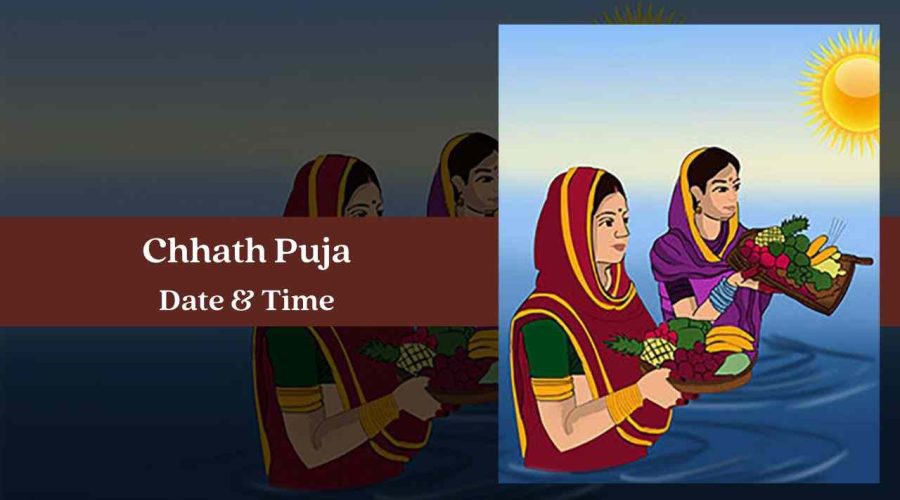Chhath Puja 2023: Know the Dates, Timing, Pooja Vidhi, and Significance
Article Rating
☆☆☆☆☆ 3.9/5
On Kartik Shukla Shashthi, Chhath Puja, also known as Sun Shashthi, is observed. This event takes place six days after Diwali and is mostly observed in the states of Uttar Pradesh, Bihar, and Jharkhand. Worshiping the Sun God and Chhathi Maiya on Chhath Puja will bring you health, money, and happiness. Chhath Pooja has taken on a new meaning as a folk event in recent years. This is why the holiday is marked by a lot of pomp and circumstance.
The Sun God is honored during the Chhath Puja. The sun is the deity that can be seen by everyone and is the source of life for all living things on the planet. On this day, Chhathi Maiya is worshipped alongside the Sun God. Chhathi Maiya or Chhathi Mata, according to Vedic Astrology, protects and gives longevity to the progeny.
Chhath Puja Date 2023
Chhath Puja or Surya Shashthi 2023
Nahay-Khay First Day of Chhath Festival – 17 November 2023
Kharna and Lohanda Second Day of Chhath Festival – 18 November 2023
Sandhya Arghya Third Day of Chhath Festival – 19 November 2023
Usha Arghya Fourth Day of Chhath Festival – 20 November 2023
Sunrise on Chhath Puja Day: 20 November 2023 at 06:47 AM
Sunset on Chhath Puja Day: 20 November 2023 at 05:56 PM
Shashthi Devi has also been referred to as Manas Daughter of Brahma ji in Hinduism. She is also said to be the mother Katyayani, who is venerated on Navratri on the Shashti date, according to the Puranas. In the Bihar-Jharkhand dialect, Shashthi Devi is known as Chhath Maiya.
Chhath Puja Days and Rituals
- The first day of Chhath Puja is Nahay Khay. To shield the mind from the vindictive propensity, the house is cleaned after washing, and vegetarian cuisine is eaten.
- The second day of Chhath Puja is Kharna. The word kharna refers to a 24-hour fast. The devotees are not allowed to consume even a drop of water on this day. They can have gur ki kheer (jaggery kheer), fruits, and ghee-rich chapati in the evening.
- During the Kartik Shukla Shashthi, on the third day of Chhath puja, an arghya is offered to the sun god. After offering an arghya to the sun with their families in the evening, worshippers decorate a bamboo basket with fruits, thekua, and rice laddus. Water and milk are offered to the Sun God during Arghya, and the Chhathi Maiya is worshipped from a soop filled with prasad. Shashthi Devi hymns are sung at night after the Sun God is worshipped, and the vrat katha is heard.
- An arghya is offered to the Sun God on the last day of Chhath puja in the morning. On this day, worshippers must go to the riverside before sunrise to offer an arghya to the rising sun. Following that, peace is sought through the protection of the child from Chhathi maiya and the happiness of the entire family. Devotees drink sharbat and raw milk after worship and consume a small amount of prasad to break their fast, which is known as Paran or Parana.
Chhath Puja Vidhi
Before the Chhath puja, gather all the samagri and offer an arghya to the Sun God:
- Three huge bamboo baskets, three bamboo or brass soop, a dish, milk, and glass Rice, scarlet vermilion, lamp, coconut, turmeric, sugarcane, suthani, veggie, and sweet potato.
- In the bamboo basket, place the aforesaid Chhath puja samagri. Place the entire prasad in the soop and light the lamp there. The women then stand in knee-deep water, holding traditional soops, to offer an arghya to the sun.
Significance of Chhath Puja
Chhath Puja is a religious and culturally significant holiday. This is the only event where the Sun God is honored and an arghya is offered. The Hindu religion places a high value on the worship of the sun. We can only see him since he is the only God we can see on a regular basis. The Sun God is referred to in the Vedas as the world’s soul. The sun’s light has the capacity to kill a variety of diseases. The person gains health, prosperity, and self-confidence as a result of the sun’s fortunate effect. The sun is supposed to be a factor of the soul, parent, ancestor, respect, and high government services in Vedic astrology.
On the Chhath Puja, a person, children, pleasure, and desire are accomplished via worship of the Sun god and Shashti Maiya. The festival’s key cultural aspect is the simplicity of tradition, as well as a passion for purity and the environment.
Frequently Asked Questions
1. Who first started Chhath Puja?
Lord Rama is thought to be responsible for the beginning of Chhath Puja. When Lord Rama returned to Ayodhyana, legend has it that he and his wife Sita observed a fast in reverence of the Sun god, breaking it only when the sunset. It is one of these rituals that has evolved into Chhath Puja.
2. Why is Chhath celebrated?
Chhath Puja is one of the Hindu religion’s most important and holy events. Chhath Puja is held after the festival of lights and Bhai Dooj to deify and pray to the Sun. Chhath Puja is a Hindu festival that originated in India and is mentioned in the Vedas.
3. Which is the toughest festival in India?
Chhath is an ancient celebration devoted to the Sun God that takes place on the sixth day after Diwali. Chhath is regarded one of the most difficult celebrations because the rites take place across four days.
4. Which God is Worshipped in chhath?
In northern India, Chhath Puja is a prominent event. Chhath Puja is a major Hindu holiday held largely in Bihar, Jharkhand, and Uttar Pradesh in northern India. During these four days, devotees worship Surya Dev, the Hindu Sun God.

